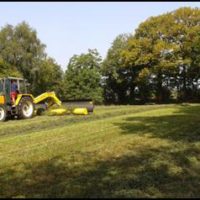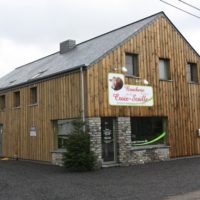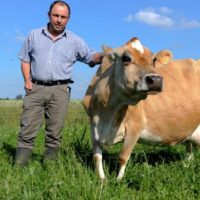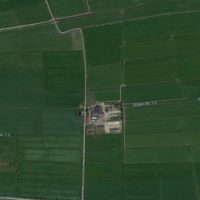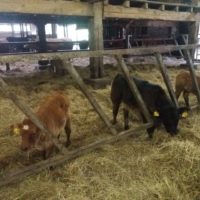A collective hay dryer in barn
Description
Background
Stéphane LORIN’s farm (GAEC de la Bos) is located in the west of France, in the north-west of the department of Mayenne. In this area, the climate is oceanic, and the soils are generally healthy and silty-clayey. This is therefore a very favorable context for the growth of grasslands. It is a region where dairy cow farming is the most common animal breeding system. Forage systems rely on pasture harvesting from March to November, and on corn silage to fill periods when the grass is not or not enough productive. The use of protein concentrates (especially soybean and rapeseed meal) is therefore very common.
Thus, 2016, an anaerobic digestion unit and 24 farmers from the sector, have joined forces to valorize part of the heat of the methanizer by drying high-protein forage. They have created a collective drying unit, and organized themselves to supply it regularly and continuously. Among these farmers, Stéphane LORIN of GAEC de la Bos is today the president of this organization. For the biogas company, the objective is to be able to recover the heat produced by the methanizer,
which also produces electricity. For farmers, the organization’s interest is to be able to produce protein-rich feeds at a reasonable cost, thus gaining autonomy, being less dependent on inputs, and reducing production costs and workload on their farms.
Detailed description
Stéphane LORIN, like every other farmer in the group, has signed a contract with the company that operates the anaerobic digestion and drying unit. In this contract, he has pledged to dedicate some grasslands, alfalfa or red clover, to the production of dried fodder. In return, the company that operates the methanizer and the dryer has pledged to dry the fodder produced, and is responsible for the harvest, as well as the delivery of dry fodder on the farm.
Therefore, the farmer is responsible for the agronomic management of the area involved. He thus deals with the sowing, the fertilization, and possibly the weeding of his grasslands, alfalfa or red clover. He is also responsible for mowing, tedding and swathing of his plots. The farmer does not pledge to deliver a specific volume, or even to provide a sufficiently dry fodder to facilitate drying operations (60% DM approximately), but he tries, as much as possible, to inform the manager of the dryer, and provide him with a forage easy to dry.
After being dried, the forage is analyzed and returned to the farmer. He is therefore responsible for its storage and preservation, and has the information to integrate it into the rations of his animals in production. He is responsible for adapting to fluctuations in the quality of the produced forage his feeding system.
To manage all these parameters, and progress in the control of these forages, Stéphane and all farmers in the group are accompanied by the Chamber of Agriculture. Each year, an advisor regularly visits the dedicated plots, and exchanges with farmers on all technical aspects, from agronomy to animal valuation. It determines in particular a schedule of harvests, which is suitable for both the farmers members of the group and the manager of the dryer.
In this context, the farmers and the advisor set up a number of tests in order to respond concretely to the problems they face. These tests range from the agronomic management of fodder to animal valuation. The farmers group also meets regularly to organize themselves, coordinate with the dryer, and share their successes and failures. The purpose of these exchanges is to bring the group to collective progress.
Results
In 2018, 739 tDM of fodder was dried. In 2017, it was 653 tMS. Alfalfa accounted for almost 60% of the volume produced in 2017, and it was reduced to 50% in 2018, to give more space to forage that can be harvested in offset (grasslands based on Italian Rye-Grass, or flora varied grasslands, and red clover).
Yields achieved between 2017 and 2018 have not improved. On the other hand, the crop chains were more efficient because the fodder remained on the ground an average of 13 hours less between mowing and harvest, and was harvested on average with 11% more DM.
Regarding animal performance, there was an overall reduction in concentrate purchases of 7% between 2016 and 2018. The contribution of innovation in terms of autonomy is still quite modest.
However, most of farmers have noticed significant gains in productivity and / or quality of the milk produced (fat and protein rate), since the incorporation of forage from the dryer into the dairy cows diet. Overall, it was also noticed that the general health status of the animals has been improved. Metabolic diseases, as well as reproductive problems are a priori less common since the introduction of these fodder.
As far as farmers are concerned, so far it does not seem that fodder has an impact on the economic results of farms (neither positive nor negative). The high cost of these fodder is today more or less offset by the best animal performance. Regarding workloads, it has been noticed that the storage type of products (bulk) significantly reduces the rations preparation time, as there are fewer tarpaulins and strings to handle.
Adoption criteria
The first success factor of a collective drying unit is that the forage drying unit must be very close geographically to each of the member farms. In the case of the Nord-Mayenne group, all farmers are within 15 km of the methanizer. Already, for those who are the furthest away, the cost of transporting fodder means that their economic interests are lower, which makes them less likely to strongly develop the partnership.
In the same way, the project works because, on the one hand, the pedoclimatic context is very favorable for the growth of legumes and grasslands specifically intended for this use. In parallel, these are systems in which the forage produced is particularly well valued by animals. In less favorable contexts and / or in more self-reliant and less dependent livestock systems, the economic stakes involved in this type of approach would probably be less important.
Finally, the project works today because the different actors are accompanied and coordinated. The diversity of crops to be valued by the dryer is, for example, essential to the good functioning of the system as a whole. Indeed, this diversity allows to spread and distribute the harvest dates within the group, and thus allows the drying unit to operate continuously, without being saturated. Thus, the work of accompaniment and coordination between the members of the group is essential to avoid that everyone is aiming for the same harvest periods, and that this does not get into significant quality decreases in the finished products, which can generate tension within the group.
Future prospects
In 2019, the capacity of the dryer, as well as the quantity of available heat will be doubled. The project will open up to other farmers in the region. A new stakeholder has already joined the project. In the already-members farms, the committed surfaces will also be increased, because the fodder obtained are satisfactory.
The expertise of the general agronomy of this type of fodder, the chains of harvest, as well as the processes of drying, and of valuation animal are in good way. However, there is still room for improvement, and means have been and are being mobilized to meet them in the future.
The economic interest of the innovation is not yet obvious. However, good hopes for progress on the added value of these fodder in terms of animal production emerge within the group.
However, the organization of the harvests between the different members remains and will remain the main limit of the project. Climatic windows are limited to produce good fodder, as well as the capacity of the dryer. It will be difficult to guarantee optimum forage quality for each of the harvesting sites. In the West of France, anaerobic digestion projects are multiplying, and some project promoters are looking closely at what is being done within the group, why not use heat for this purpose. However, this constitutes a rather heavy additional investment for the structure exploiting the anaerobic digestion, and is viable only if there is a sufficient number of dynamic farmers around for the project, which is fortunately the case for this North Mayenne group.
Additional information
| Farming system | conventional farming |
|---|---|
| Domains of innovation | animal feeding management, forage conservation technique, legume management – Perennial legumes |
| Main types of animal | dairy cattle |
| Country | France |
| Product type | Case study |
| Language | English |

